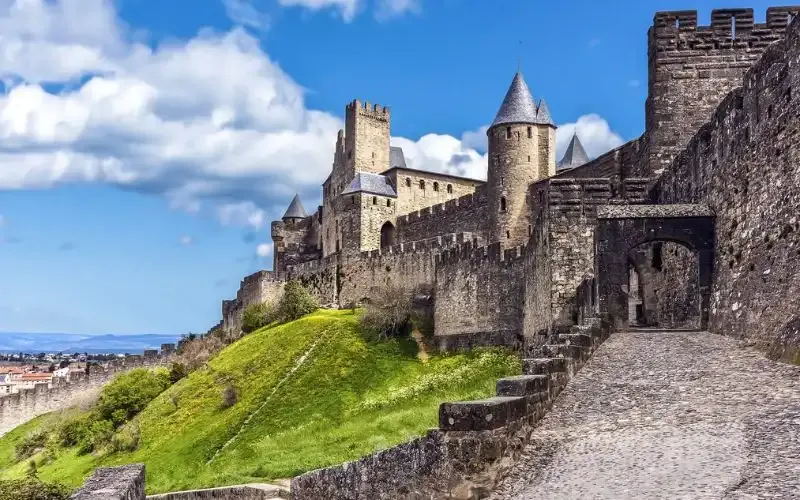Steeped in history, the ancient city of Carcassonne stands proudly, a living testament to a glorious medieval era. With its unique architecture and captivating historical narratives, Carcassonne is an unmissable destination on any journey through France. Join “Du lịch khắp thế gian” as we unveil the secrets of this magnificent fortress city and feel the pulse of time right here.
A Glimpse into the Carcassonne Citadel
Where is Carcassonne? Journey to the Emerald Gem
The fortress city of Carcassonne is located in the Occitanie region of southwestern France, approximately 700km from Paris. Nestled on the right bank of the serene Aude River, in the Aude department, Carcassonne emerges like a fairytale scene with its majestic castles stretching one after another, forming one of Europe’s most formidable fortresses. This strategic location has played a crucial role in French history.

Impressive Architecture: Echoes of the Middle Ages
Carcassonne is stunning with its ancient beauty, deeply imbued with medieval military architectural style, highlighted by its grand scale and high defensive capabilities. Renowned as Europe’s largest fortress, this structure comprises two solid layers of walls and numerous internal areas, all built from stone. The blend of Roman and Gothic architecture creates a harmonious and unique ensemble.

The outer wall was built on a rocky promontory dating back to Roman times, allowing visitors to observe the entire valley and the Aude plain. Massive stones are bonded with sturdy mortar, forming a thick, solid wall. The second wall encloses the first wall, enhancing the fortress’s defensive capabilities.
The four corners of the citadel feature four main gates: the Narbonnaise Gate to the east, the Saint-Nazaire Gate to the south, the Aude Gate to the west, and the Bourg (or Rodez) Gate to the north. Each gate boasts a distinct architectural style, contributing to Carcassonne’s diversity and uniqueness.

Inside the fortress is a castle built from 1130, featuring a protective tower and two L-shaped buildings. The second largest structure is the Saint-Nazaire Basilica, constructed from sandstone. Stone-paved streets, ancient houses, and craft shops create a vibrant space, transporting visitors back to the Middle Ages.
Perched on a high hill with panoramic views, Carcassonne held a strategically important military position in France’s historical battles. Although wars are long gone, the fortress retains its ancient charm through the architectural masterpieces that remain. In 1997, UNESCO recognized the entire architectural complex as a World Heritage Site, affirming Carcassonne’s immense historical and cultural value.
Ideal Time to Visit Carcassonne
Carcassonne has a humid subtropical climate, influenced by Mediterranean weather. The best time to visit is during spring (April-June) or autumn (September-November). During these months, the weather is warm and dry, ideal for sightseeing and exploration. Summers here are quite hot due to low rainfall, while winters are cold. Choosing the right time will ensure you have a complete and memorable trip.

Must-Visit Attractions in Enchanting Carcassonne
Beyond its long history, Carcassonne captivates visitors with the radiant beauty of its famous landmarks:
Saint-Nazaire Basilica: Witness to History
The Saint-Nazaire Basilica is a Roman Catholic structure named after one of the city’s patron saints. Built from the 12th to the 14th centuries and restored multiple times, the basilica is a stone masterpiece blending ancient Roman and Romanesque styles. The columns in front of the nave are clad in smooth stone, while the upper levels are built of brick. With its soaring columns, arches, and windows, the basilica evokes a sense of mystery and grandeur.

Inside, the basilica is adorned with artworks and religious paintings. Visitors can admire works by renowned 19th-century artists such as François-Auguste Biard and Théodore Chassériau. The basilica also hosts various activities such as prayer services, art exhibitions, and more. This place holds sacred significance and is a source of pride for the French people.
Narbonne Tower: The City’s Highest Point
The city of Carcassonne has a total of 53 watchtowers, and Narbonne Tower is one of the most beloved destinations for visitors. Built in the 13th century, the tower is located near the Narbonnaise Gate, the largest gate of the ancient city. Narbonne Tower stands approximately 50 meters tall with classical architecture, especially the prominent stone arches above the windows. It was also one of the city’s important defensive towers, used to monitor and protect citizens during wartime.

Visitors can reach the tower by horse-drawn carriage and admire the panoramic view of the fortress city of Carcassonne. A special feature of this tower is that it once housed a massive granary, feeding the troops during fierce wartime days.
Basse-Carcassonne: Modern Beauty on the Banks of the Aude River
Besides the ancient Carcassonne Citadel, visitors can explore the neighboring Basse-Carcassonne (Lower City). Famous for its economic development, Basse-Carcassonne also boasts a harmonious beauty blessed by nature. This city lies on the other side of the poetic Aude River, an attractive destination with modern architecture and a vibrant pace of life.

Conclusion
As a testament to France’s glorious history, the fortress city of Carcassonne stands tall, welcoming visitors to explore and discover. A trip to Carcassonne is not just a tour; it’s a journey back in time, exploring unique historical and cultural values. If you have the chance to visit France, don’t miss the opportunity to discover the emerald gem of Carcassonne and experience the wonders this city offers. Are you ready for your Carcassonne adventure?